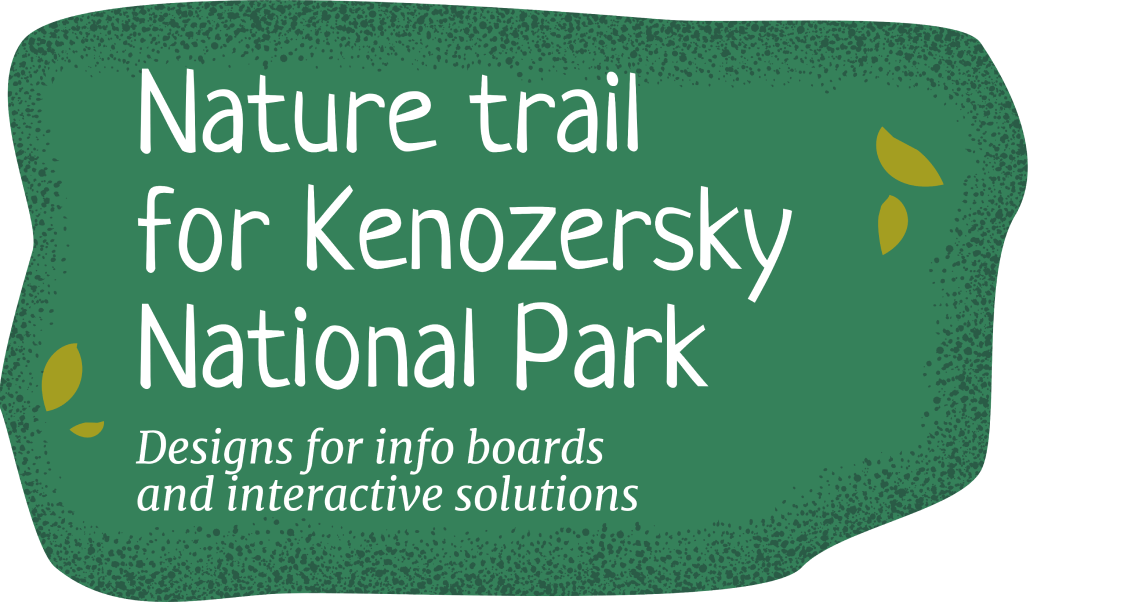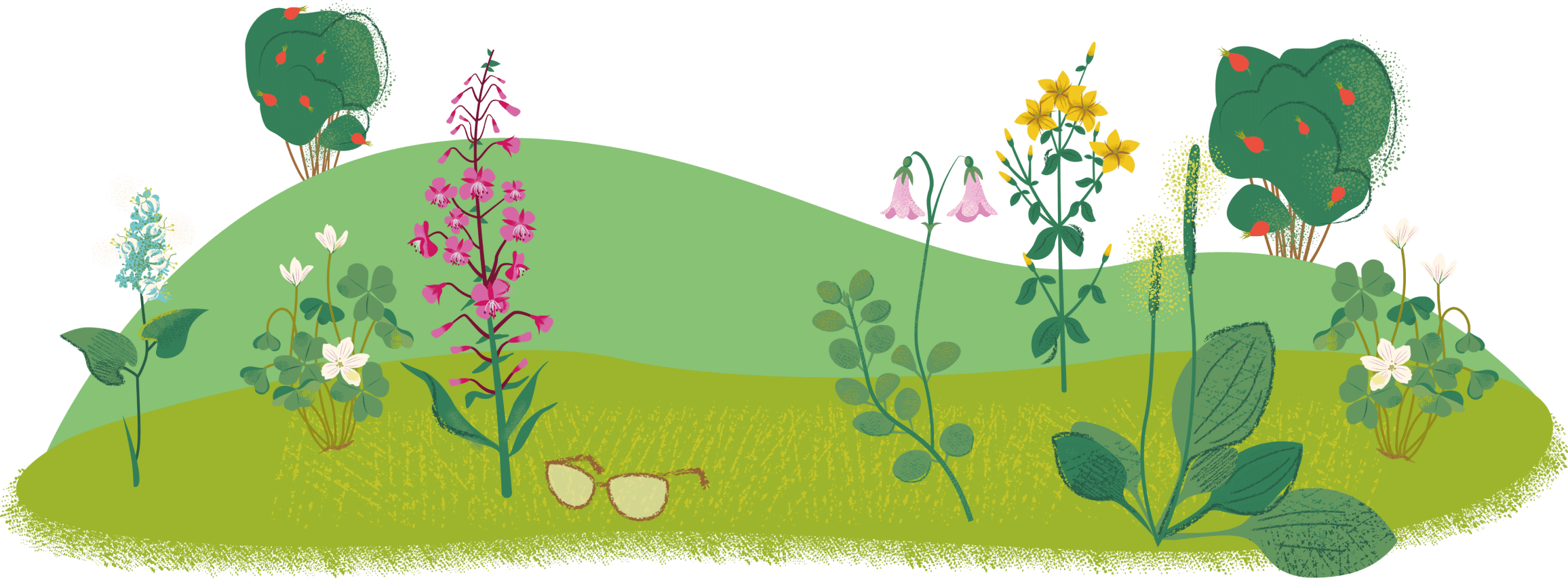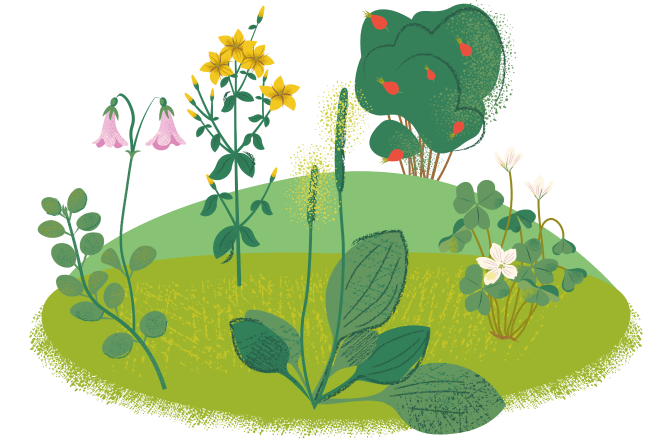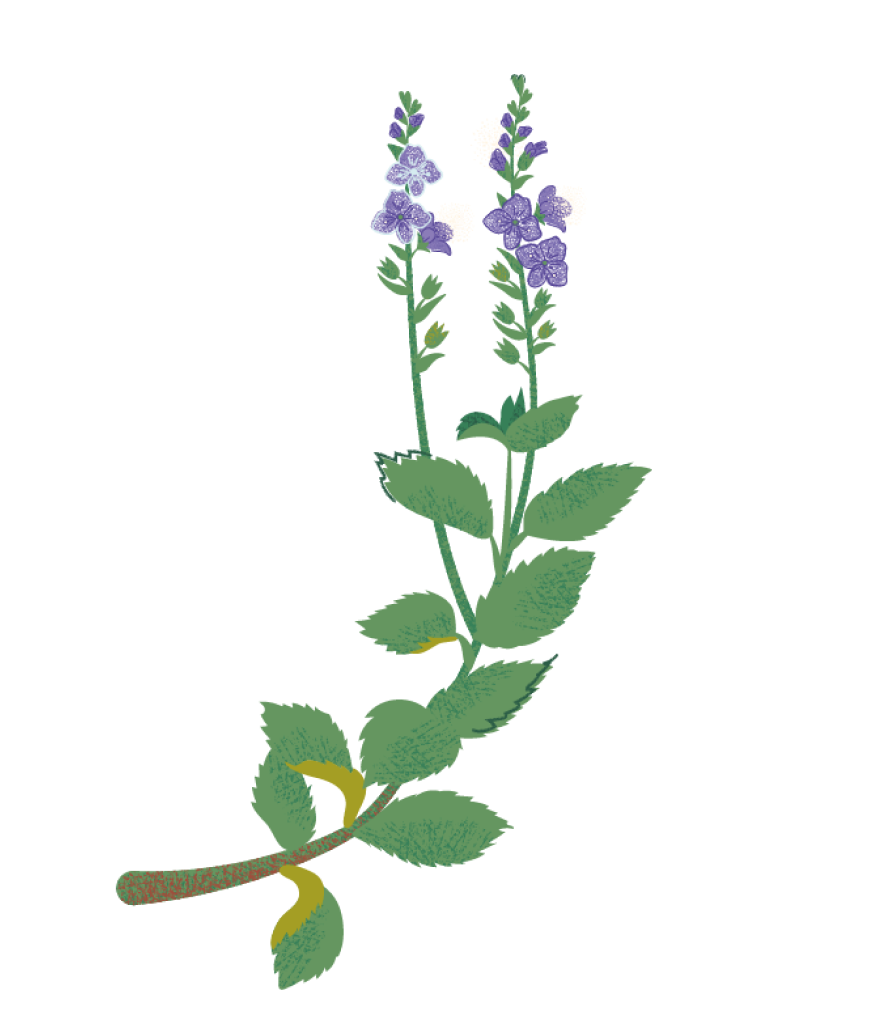



The idea to put up a nature trail was inspired by Charles Darwin’s "Thinking Path", which he walked near his house. The scientist took the walk even in bad weather to calm down and find the right solutions to his most challenging tasks.
Having taken the example of the famous naturalist, Kenozersky National Park staff along with Lyokshmozero region community decided to create their own "Thinking Path". Not only does the route include the most interesting types of plants of the Russian North, but it also motivates people to think about the importance of treating nature with care
Having taken the example of the famous naturalist, Kenozersky National Park staff along with Lyokshmozero region community decided to create their own "Thinking Path". Not only does the route include the most interesting types of plants of the Russian North, but it also motivates people to think about the importance of treating nature with care
Экологическая тропа для Кенозерского национального парка

Project Goals
Concept
To introduce typical vegetation of the region to local people and visitors of the Kenozersky National Park.

To put people in a philosophical mood and encourage them to think about the value of natural heritage with the help of quotes and sayings of great philosophers, writers, poets, artists, and scientists about nature.

To check knowledge through game play.


The idea to put up a nature trail was inspired by Charles Darwin’s "Thinking Path", which he walked near his house. The scientist took the walk even in bad weather to calm down and find the right solutions to his most challenging tasks.
Having taken the example of the famous naturalist, Kenozersky National Park staff along with Lyokshmozero region community decided to create their own "Thinking Path". Not only does the route include the most interesting types of plants of the Russian North, but it also motivates people to think about the importance of treating nature with care
Having taken the example of the famous naturalist, Kenozersky National Park staff along with Lyokshmozero region community decided to create their own "Thinking Path". Not only does the route include the most interesting types of plants of the Russian North, but it also motivates people to think about the importance of treating nature with care

Project Goals
Concept
To introduce typical vegetation of the region to local people and visitors of the Kenozersky National Park.

To put people in a philosophical mood and encourage them to think about the value of natural heritage with the help of quotes and sayings of great philosophers, writers, poets, artists, and scientists about nature.

To check knowledge through game play.


Contents
Each info board on the route tells about one of the twenty plants growing in the Lake Kenozero area. The stands include exact scientific names of the plants, fun facts, health benefits and information about how people put each plant to use. The narrators of the texts are plants themselves: birch tree, rose plant, clubmoss, lingonberry, lily of the valley, Saint John’s wort, and other plants engage in direct dialogue with the hikers of the nature trail — simple, accessible and heartfelt dialogue.
Our designers did their best to present the information in a brief and vivid way with the help of infographics, original drawings and interactive solutions.
info boards with game tasks allow to check if the information has been memorized well. The stands include tasks that offer to tell the difference between the species of plants as well as questions about useful, poisonous, rare and unusual plants.
Our designers did their best to present the information in a brief and vivid way with the help of infographics, original drawings and interactive solutions.
info boards with game tasks allow to check if the information has been memorized well. The stands include tasks that offer to tell the difference between the species of plants as well as questions about useful, poisonous, rare and unusual plants.

Contents
Each info board on the route tells about one of the twenty plants growing in the Lake Kenozero area. The stands include exact scientific names of the plants, fun facts, health benefits and information about how people put each plant to use. The narrators of the texts are plants themselves: birch tree, rose plant, clubmoss, lingonberry, lily of the valley, Saint John’s wort, and other plants engage in direct dialogue with the hikers of the nature trail — simple, accessible and heartfelt dialogue.
Our designers did their best to present the information in a brief and vivid way with the help of infographics, original drawings and interactive solutions.
info boards with game tasks allow to check if the information has been memorized well. The stands include tasks that offer to tell the difference between the species of plants as well as questions about useful, poisonous, rare and unusual plants.
Our designers did their best to present the information in a brief and vivid way with the help of infographics, original drawings and interactive solutions.
info boards with game tasks allow to check if the information has been memorized well. The stands include tasks that offer to tell the difference between the species of plants as well as questions about useful, poisonous, rare and unusual plants.

Contents
Each info board on the route tells about one of the twenty plants growing in the Lake Kenozero area. The stands include exact scientific names of the plants, fun facts, health benefits and information about how people put each plant to use. The narrators of the texts are plants themselves: birch tree, rose plant, clubmoss, lingonberry, lily of the valley, Saint John’s wort, and other plants engage in direct dialogue with the hikers of the nature trail — simple, accessible and heartfelt dialogue.
Our designers did their best to present the information in a brief and vivid way with the help of infographics, original drawings and interactive solutions.
Our designers did their best to present the information in a brief and vivid way with the help of infographics, original drawings and interactive solutions.

info boards with game tasks allow to check if the information has been memorized well. The stands include tasks that offer to tell the difference between the species of plants as well as questions about useful, poisonous, rare and unusual plants.
The game stands are accompanied by info boards with the quotes of great philosophers, writers, artists and poets about the importance of treating nature with care. They are decorated with photos of Lake Kenozero landscapes.
The game stands are accompanied by info boards with the quotes of great philosophers, writers, artists and poets about the importance of treating nature with care. They are decorated with photos of Lake Kenozero landscapes.
The game stands are accompanied by info boards with the quotes of great philosophers, writers, artists and poets about the importance of treating nature with care. They are decorated with photos of Lake Kenozero landscapes.

The main guide along the trail is Charles Darwin — a specially created character impersonating the scientist welcomes guests and leads them from stand to stand.
The main guide along the trail is Charles Darwin — a specially created character impersonating the scientist welcomes guests and leads them from stand to stand.

The main guide along the trail is Charles Darwin — a specially created character impersonating the scientist welcomes guests and leads them from stand to stand.

Design
Our job was to develop a design that would vividly present the information about the plants of the national park, arrange the game tasks and complement the philosophical quotes with photos of Lake Kenozero landscapes.
The important part of the job was to make the design match the decorations of the entrance group created by "Sbornaya Taiboli", a monumental art team. They erect large-scale monuments, create murals, make kinetic fire sculptures, and art objects from ice and snow, as well as organizing an open-air festival and carrying out international cultural projects.
The important part of the job was to make the design match the decorations of the entrance group created by "Sbornaya Taiboli", a monumental art team. They erect large-scale monuments, create murals, make kinetic fire sculptures, and art objects from ice and snow, as well as organizing an open-air festival and carrying out international cultural projects.
Design
Our job was to develop a design that would vividly present the information about the plants of the national park, arrange the game tasks and complement the philosophical quotes with photos of Lake Kenozero landscapes.
The important part of the job was to make the design match the decorations of the entrance group created by "Sbornaya Taiboli", a monumental art team. They erect large-scale monuments, create murals, make kinetic fire sculptures, and art objects from ice and snow, as well as organizing an open-air festival and carrying out international cultural projects.
The important part of the job was to make the design match the decorations of the entrance group created by "Sbornaya Taiboli", a monumental art team. They erect large-scale monuments, create murals, make kinetic fire sculptures, and art objects from ice and snow, as well as organizing an open-air festival and carrying out international cultural projects.
Design
Our job was to develop a design that would vividly present the information about the plants of the national park, arrange the game tasks and complement the philosophical quotes with photos of Lake Kenozero landscapes.
The important part of the job was to make the design match the decorations of the entrance group created by "Sbornaya Taiboli", a monumental art team. They erect large-scale monuments, create murals, make kinetic fire sculptures, and art objects from ice and snow, as well as organizing an open-air festival and carrying out international cultural projects.
The important part of the job was to make the design match the decorations of the entrance group created by "Sbornaya Taiboli", a monumental art team. They erect large-scale monuments, create murals, make kinetic fire sculptures, and art objects from ice and snow, as well as organizing an open-air festival and carrying out international cultural projects.

The main idea for the design concept was a scientist’s notebook — a botanical sketchbook with images of plants that speak to the reader. This helped to define the style of the drawings. The main illustrations were followed by sketches and infographics. We arranged all the elements on the info boards randomly to create the image of real scientist’s notes, which are usually written down hastily at a spare minute.
All stands were connected by a common thread — a path winding through all the stands, as well as drawings reminding the viewer of Charles Darwin. Some included his portrait, others — a detail: glasses, a quill, books, a hat.
The main idea for the design concept was a scientist’s notebook — a botanical sketchbook with images of plants that speak to the reader. This helped to define the style of the drawings. The main illustrations were followed by sketches and infographics. We arranged all the elements on the info boards randomly to create the image of real scientist’s notes, which are usually written down hastily at a spare minute.
All stands were connected by a common thread — a path winding through all the stands, as well as drawings reminding the viewer of Charles Darwin. Some included his portrait, others — a detail: glasses, a quill, books, a hat.
All stands were connected by a common thread — a path winding through all the stands, as well as drawings reminding the viewer of Charles Darwin. Some included his portrait, others — a detail: glasses, a quill, books, a hat.

The main idea for the design concept was a scientist’s notebook — a botanical sketchbook with images of plants that speak to the reader. This helped to define the style of the drawings. The main illustrations were followed by sketches and infographics. We arranged all the elements on the info boards randomly to create the image of real scientist’s notes, which are usually written down hastily at a spare minute.
All stands were connected by a common thread — a path winding through all the stands, as well as drawings reminding the viewer of Charles Darwin. Some included his portrait, others — a detail: glasses, a quill, books, a hat.
All stands were connected by a common thread — a path winding through all the stands, as well as drawings reminding the viewer of Charles Darwin. Some included his portrait, others — a detail: glasses, a quill, books, a hat.

We chose light colors for the boards to make it easier for the visitors to read the information. The main shades in the design were natural colors of paved forest paths and vegetation. The chosen colour palette also worked in accordance with the Kenozersky National Park’s request — make the info boards smoothly blend in with the natural surroundings.
We also added a shade of delicate blue — it served as a background color for the text in English. It perfectly goes with the other shades and serves as a hint for the English speaking visitors at the same time.
We also added a shade of delicate blue — it served as a background color for the text in English. It perfectly goes with the other shades and serves as a hint for the English speaking visitors at the same time.

We chose light colors for the boards to make it easier for the visitors to read the information. The main shades in the design were natural colors of paved forest paths and vegetation. The chosen colour palette also worked in accordance with the Kenozersky National Park’s request — make the info boards smoothly blend in with the natural surroundings.
We also added a shade of delicate blue — it served as a background color for the text in English. It perfectly goes with the other shades and serves as a hint for the English speaking visitors at the same time.
We also added a shade of delicate blue — it served as a background color for the text in English. It perfectly goes with the other shades and serves as a hint for the English speaking visitors at the same time.

We chose light colors for the boards to make it easier for the visitors to read the information. The main shades in the design were natural colors of paved forest paths and vegetation. The chosen colour palette also worked in accordance with the Kenozersky National Park’s request — make the info boards smoothly blend in with the natural surroundings.
We also added a shade of delicate blue — it served as a background color for the text in English. It perfectly goes with the other shades and serves as a hint for the English speaking visitors at the same time.
We also added a shade of delicate blue — it served as a background color for the text in English. It perfectly goes with the other shades and serves as a hint for the English speaking visitors at the same time.


For the headlines we picked a font that would suit the style of the illustrations — round, succinct, resembling of handwriting but legible. For the main text we chose a straight font and used italics for direct speech.
For the headlines we picked a font that would suit the style of the illustrations — round, succinct, resembling of handwriting but legible. For the main text we chose a straight font and used italics for direct speech.

For the headlines we picked a font that would suit the style of the illustrations — round, succinct, resembling of handwriting but legible. For the main text we chose a straight font and used italics for direct speech.

Working on each of the info boards, our designers created a series of original illustrations depicting each of the twenty plants. To do this, together with science consultants, they studied the botanical portraits of the main characters and depicted their features in detail to make the drawings scientifically accurate and the plants as recognizable as possible.
Illustrations


In addition, the designer team made a series of illustrations presenting facts and objects connected with the plants. As a result, the stands were topped up with medicine bottles, birch baskets, jars of jam, tea cups, dried flower bags and leather goods.

In addition, the designer team made a series of illustrations presenting facts and objects connected with the plants. As a result, the stands were topped up with medicine bottles, birch baskets, jars of jam, tea cups, dried flower bags and leather goods.

In addition, the designer team made a series of illustrations presenting facts and objects connected with the plants. As a result, the stands were topped up with medicine bottles, birch baskets, jars of jam, tea cups, dried flower bags and leather goods.


A separate task was to create portraits of the main characters for the opening stand: Elena Shatkovskaya, director of Kenozersky National Park, Konstantin Paustovsky, Russian writer and, of course, Charles Darwin.
A separate task was to create portraits of the main characters for the opening stand: Elena Shatkovskaya, director of Kenozersky National Park, Konstantin Paustovsky, Russian writer and, of course, Charles Darwin.

A separate task was to create portraits of the main characters for the opening stand: Elena Shatkovskaya, director of Kenozersky National Park, Konstantin Paustovsky, Russian writer and, of course, Charles Darwin.

Interactive solutions
To arrange the game stands, we applied some interactive solutions.
Two games await the visitors at the end of the nature trail. The first one suggests checking your knowledge of the plants. The stands are equipped with moving elements with questions. To find out the answer, the player must move the element to the side.
Two games await the visitors at the end of the nature trail. The first one suggests checking your knowledge of the plants. The stands are equipped with moving elements with questions. To find out the answer, the player must move the element to the side.

Interactive solutions
To arrange the game stands, we applied some interactive solutions.
Two games await the visitors at the end of the nature trail. The first one suggests checking your knowledge of the plants. The stands are equipped with moving elements with questions. To find out the answer, the player must move the element to the side.
Two games await the visitors at the end of the nature trail. The first one suggests checking your knowledge of the plants. The stands are equipped with moving elements with questions. To find out the answer, the player must move the element to the side.

Interactive solutions
To arrange the game stands, we applied some interactive solutions.
Two games await the visitors at the end of the nature trail. The first one suggests checking your knowledge of the plants. The stands are equipped with moving elements with questions. To find out the answer, the player must move the element to the side.
Two games await the visitors at the end of the nature trail. The first one suggests checking your knowledge of the plants. The stands are equipped with moving elements with questions. To find out the answer, the player must move the element to the side.


The second one is a memory game. There are cubes with the names of the plants on one side and their images on the other. Visitors can train their ability to tell the plants apart and remember their exact names by turning each cube one by one to form pairs of the same image. You can play this game alone or with friends while you walk the trail.
These interactive solutions help to make visitors' interaction with the info boards more diverse while the direct contact allows to gradually dive into the topic and remember the facts. Therefore, visitors of the "Thinking Path" don’t just get a brief understanding of the plants along the route but also come back from the hike with new knowledge.
These interactive solutions help to make visitors' interaction with the info boards more diverse while the direct contact allows to gradually dive into the topic and remember the facts. Therefore, visitors of the "Thinking Path" don’t just get a brief understanding of the plants along the route but also come back from the hike with new knowledge.
The second one is a memory game. There are cubes with the names of the plants on one side and their images on the other. Visitors can train their ability to tell the plants apart and remember their exact names by turning each cube one by one to form pairs of the same image. You can play this game alone or with friends while you walk the trail.
These interactive solutions help to make visitors' interaction with the info boards more diverse while the direct contact allows to gradually dive into the topic and remember the facts. Therefore, visitors of the "Thinking Path" don’t just get a brief understanding of the plants along the route but also come back from the hike with new knowledge.
These interactive solutions help to make visitors' interaction with the info boards more diverse while the direct contact allows to gradually dive into the topic and remember the facts. Therefore, visitors of the "Thinking Path" don’t just get a brief understanding of the plants along the route but also come back from the hike with new knowledge.

The second one is a memory game. There are cubes with the names of the plants on one side and their images on the other. Visitors can train their ability to tell the plants apart and remember their exact names by turning each cube one by one to form pairs of the same image. You can play this game alone or with friends while you walk the trail.
These interactive solutions help to make visitors' interaction with the info boards more diverse while the direct contact allows to gradually dive into the topic and remember the facts. Therefore, visitors of the "Thinking Path" don’t just get a brief understanding of the plants along the route but also come back from the hike with new knowledge.
These interactive solutions help to make visitors' interaction with the info boards more diverse while the direct contact allows to gradually dive into the topic and remember the facts. Therefore, visitors of the "Thinking Path" don’t just get a brief understanding of the plants along the route but also come back from the hike with new knowledge.

Come take a walk along the "Thinking Path" to find out about the plants of Kenozersky National Park, learn what great minds thought about taking care of nature, and seek the answers to the questions that have long been on your mind. After all, this is exactly what it’s made for!

Come take a walk along the "Thinking Path" to find out about the plants of Kenozersky National Park, learn what great minds thought about taking care of nature, and seek the answers to the questions that have long been on your mind. After all, this is exactly what it’s made for!
Come take a walk along the "Thinking Path" to find out about the plants of Kenozersky National Park, learn what great minds thought about taking care of nature, and seek the answers to the questions that have long been on your mind. After all, this is exactly what it’s made for!
Kenozersky National Park
Project team
Les


Anna Sapelnikova
Project manager
Anastasia Vasilchenko
Art director
Elena Litvinova
Assistant project manager
Tatiana Denisova
Editor
Project manager
Anastasia Vasilchenko
Art director
Elena Litvinova
Assistant project manager
Tatiana Denisova
Editor
Natalia Kalashnikova
Lead graphic designer
Ekaterina Yurchak
Graphic designer
Liubov Belova
Graphic designer
Viktoria Makarchuk
Graphic designer
Lead graphic designer
Ekaterina Yurchak
Graphic designer
Liubov Belova
Graphic designer
Viktoria Makarchuk
Graphic designer
Elena Shatkovskaya
Park director
Aleksandra Yakovleva
Chief development officer
Aleksandr Porokhin
Head of tourism development
Anastasia Kalinina
Leading specialist of the tourism development department
Evgeniy Mazilov
Leading specialist of the tourism development department
Park director
Aleksandra Yakovleva
Chief development officer
Aleksandr Porokhin
Head of tourism development
Anastasia Kalinina
Leading specialist of the tourism development department
Evgeniy Mazilov
Leading specialist of the tourism development department
Anna Sapelnikova
Project manager
Anastasia Vasilchenko
Art director
Elena Litvinova
Assistant project manager
Tatiana Denisova
Editor
Project manager
Anastasia Vasilchenko
Art director
Elena Litvinova
Assistant project manager
Tatiana Denisova
Editor
Natalia Kalashnikova
Lead graphic designer
Ekaterina Yurchak
Graphic designer
Liubov Belova
Graphic designer
Viktoria Makarchuk
Graphic designer
Lead graphic designer
Ekaterina Yurchak
Graphic designer
Liubov Belova
Graphic designer
Viktoria Makarchuk
Graphic designer
Anna Sapelnikova
Project manager
Anastasia Vasilchenko
Art director
Elena Litvinova
Assistant project manager
Tatiana Denisova
Editor
Project manager
Anastasia Vasilchenko
Art director
Elena Litvinova
Assistant project manager
Tatiana Denisova
Editor
Natalia Kalashnikova
Lead graphic designer
Ekaterina Yurchak
Graphic designer
Liubov Belova
Graphic designer
Viktoria Makarchuk
Graphic designer
Lead graphic designer
Ekaterina Yurchak
Graphic designer
Liubov Belova
Graphic designer
Viktoria Makarchuk
Graphic designer
Kenozersky National Park

Elena Shatkovskaya
Park director
Aleksandra Yakovleva
Chief development officer
Aleksandr Porokhin
Head of tourism development
Anastasia Kalinina
Leading specialist of the tourism development department
Evgeniy Mazilov
Leading specialist of the tourism development department
Park director
Aleksandra Yakovleva
Chief development officer
Aleksandr Porokhin
Head of tourism development
Anastasia Kalinina
Leading specialist of the tourism development department
Evgeniy Mazilov
Leading specialist of the tourism development department
Elena Shatkovskaya
Park director
Aleksandra Yakovleva
Chief development officer
Aleksandr Porokhin
Head of tourism development
Anastasia Kalinina
Leading specialist of the tourism development department
Evgeniy Mazilov
Leading specialist of the tourism development department
Park director
Aleksandra Yakovleva
Chief development officer
Aleksandr Porokhin
Head of tourism development
Anastasia Kalinina
Leading specialist of the tourism development department
Evgeniy Mazilov
Leading specialist of the tourism development department
Leave a request
By clicking the button you agree to the Privacy Policy
OTHER PROJECTS





